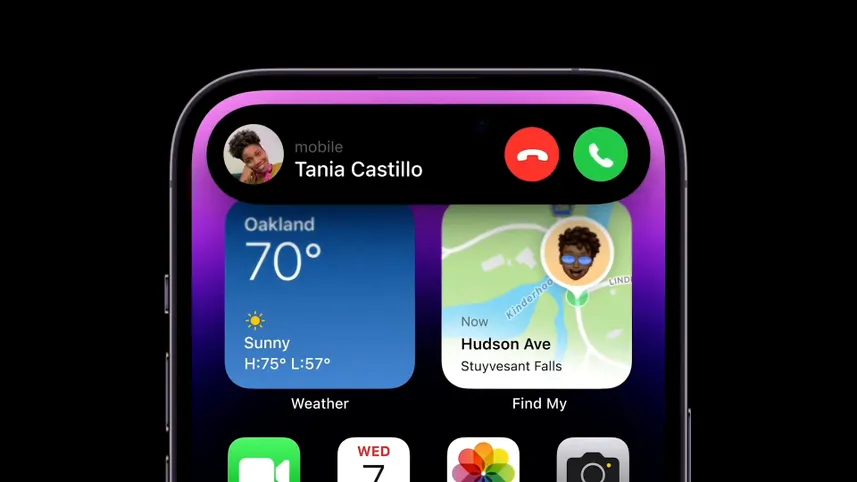The launch of the iPhone 14 Series marked a significant evolution in Apple’s design philosophy, introducing the world to the Dynamic Island. Replacing the traditional notch first seen in iPhone X, this feature represents a blend of aesthetics and functionality, offering a novel approach to interacting with the iPhone’s interface. This article explores Dynamic Island’s functionalities, its comparison with Android counterparts, and its potential future in Apple devices.
Understanding the Dynamic Island Concept
Dynamic Island isn’t just a design element; it’s a functional, interactive hub embedded in the iPhone 14 Pro Models’ display. This pill-shaped area dynamically changes its size and shape based on the activity. It houses the camera hardware, including the TrueDepth camera system used for Face ID, and seamlessly integrates with iOS to display notifications, alerts, and even controls for ongoing activities.

In many cases, you can press down on the Dynamic Island to open the activity in a larger window. In other cases, you’re able to tap the Dynamic Island to launch the activity in its full-screen app. You can also swipe on it to expand or contract the window. Here are several examples of how this works.
Core Functionalities of Dynamic Island
Dynamic Island redefines user interaction with the iPhone. Below are its key uses:
- Authenticate Apple Pay Transactions: Streamlining transactions by providing a visible and interactive prompt for authentication.
- Visualize AirDrop Transfers: Enhancing the user experience by displaying the progress of AirDrop transfers.
- Show Privacy Indicators: Offering transparency by showing indicators when the camera or microphone is in use.
- Set a Timer: Allowing users to quickly view and manage timers.
- Control Phone Calls: Integrating call controls into the Dynamic Island for ease of access.
- Follow Apple Map Directions: Displaying turn-by-turn navigation in a non-intrusive way.
- Play Music or Other Audio: Providing controls for audio playback, including music and podcasts.
- Record Your Screen: Simplifying screen recording with immediate access and control.
Comparing Dynamic Island with Android Alternatives
When compared to Android devices like the Pixel 7 Series and Galaxy S23 series, Dynamic Island stands out for its innovative approach. Android phones typically use a static notch or punch-hole for their front cameras. In contrast, Dynamic Island offers a more interactive and integrated experience, combining the display area with the front camera and Face ID module.
Advantages of Dynamic Island
- Enhanced User Interface: Dynamic Island offers a more intuitive and engaging way to interact with notifications and controls.
- Space Efficiency: It cleverly utilizes the front face of the iPhone, integrating essential sensors without compromising screen space.
- Aesthetic Appeal: The feature enhances the overall look of the iPhone, making it more modern and sleek.
Challenges and Limitations
Despite its advantages, Dynamic Island has its own challenges:
- Accessibility Issues: The placement might make it difficult for some users to comfortably interact with the feature.
- Maintenance Concerns: The proximity to the front-facing camera could lead to smudges, affecting camera clarity.
- Visibility in Different Conditions: In certain lighting, especially direct sunlight, the Dynamic Island’s visibility could be compromised.
- The Dynamic Island looks like a solid pure black pill in pictures, but in reality, it looks different. The area between spots becomes noticeable in direct sunlight, and it doesn’t look like a solid object.
Dynamic Island’s Future and Expansion
The Dynamic Island is expected to evolve further with the iPhone 15 Series. Predictions suggest that both Pro and base models (iPhone 15 and iPhone 15 Plus) will feature this innovation, possibly with enhanced functionalities and design tweaks based on user feedback.

Summary on Dynamic Island
Apple’s latest iPhone models, including the iPhone 14 upwards, feature a new shape-changing hub called Dynamic Island, which houses the front camera and Face ID module. The Dynamic Island can display alerts and notifications, control music, and more. It is necessary for Apple devices because they have many sensors, including Face ID, that require space on the display. The advantages of Dynamic Island include better visibility of ongoing activities and alerts, the ability to track flights and sports games, and the fact that it doesn’t take up space in full-screen mode. However, there are also drawbacks, such as the fact that it is located in a hard-to-reach area of the device, and it catches the user’s attention every time it activates. Overall, it is not a feature that warrants upgrading to the iPhone 14 Pro Models, and users should wait for future developments.